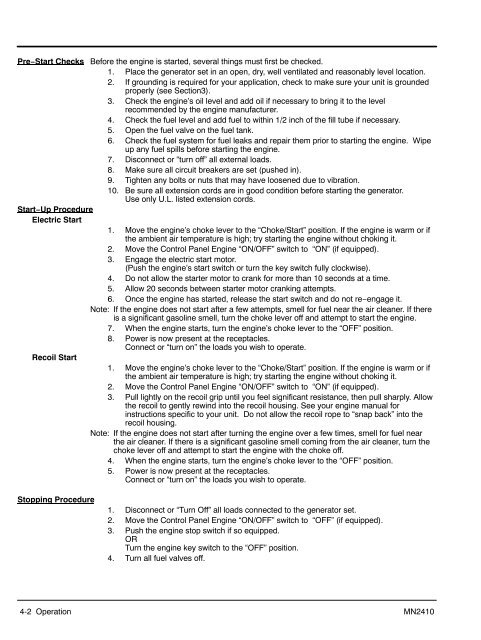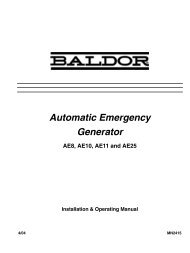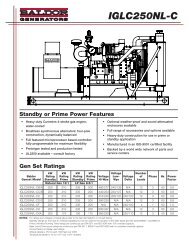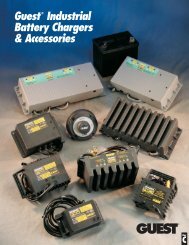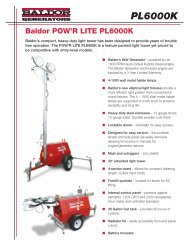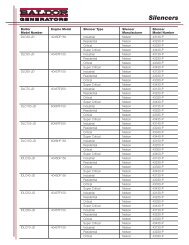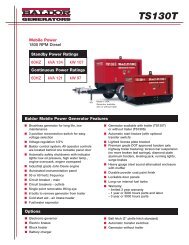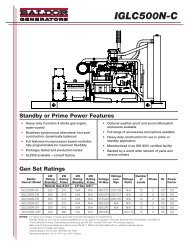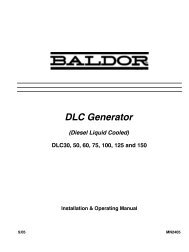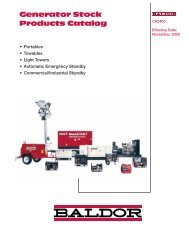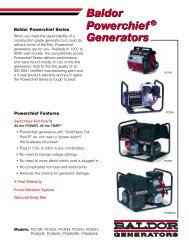Installation & Operation Manual: Portable Premier Series
Installation & Operation Manual: Portable Premier Series
Installation & Operation Manual: Portable Premier Series
Create successful ePaper yourself
Turn your PDF publications into a flip-book with our unique Google optimized e-Paper software.
Pre−Start Checks Before the engine is started, several things must first be checked.<br />
1. Place the generator set in an open, dry, well ventilated and reasonably level location.<br />
2. If grounding is required for your application, check to make sure your unit is grounded<br />
properly (see Section3).<br />
3. Check the engine’s oil level and add oil if necessary to bring it to the level<br />
recommended by the engine manufacturer.<br />
4. Check the fuel level and add fuel to within 1/2 inch of the fill tube if necessary.<br />
5. Open the fuel valve on the fuel tank.<br />
6. Check the fuel system for fuel leaks and repair them prior to starting the engine. Wipe<br />
up any fuel spills before starting the engine.<br />
7. Disconnect or “turn off” all external loads.<br />
8. Make sure all circuit breakers are set (pushed in).<br />
9. Tighten any bolts or nuts that may have loosened due to vibration.<br />
10. Be sure all extension cords are in good condition before starting the generator.<br />
Use only U.L. listed extension cords.<br />
Start−Up Procedure<br />
Electric Start<br />
1. Move the engine’s choke lever to the “Choke/Start” position. If the engine is warm or if<br />
the ambient air temperature is high; try starting the engine without choking it.<br />
2. Move the Control Panel Engine “ON/OFF” switch to “ON” (if equipped).<br />
3. Engage the electric start motor.<br />
(Push the engine’s start switch or turn the key switch fully clockwise).<br />
4. Do not allow the starter motor to crank for more than 10 seconds at a time.<br />
5. Allow 20 seconds between starter motor cranking attempts.<br />
6. Once the engine has started, release the start switch and do not re−engage it.<br />
Note: If the engine does not start after a few attempts, smell for fuel near the air cleaner. If there<br />
is a significant gasoline smell, turn the choke lever off and attempt to start the engine.<br />
7. When the engine starts, turn the engine’s choke lever to the “OFF” position.<br />
8. Power is now present at the receptacles.<br />
Connect or “turn on” the loads you wish to operate.<br />
Recoil Start<br />
1. Move the engine’s choke lever to the “Choke/Start” position. If the engine is warm or if<br />
the ambient air temperature is high; try starting the engine without choking it.<br />
2. Move the Control Panel Engine “ON/OFF” switch to “ON” (if equipped).<br />
3. Pull lightly on the recoil grip until you feel significant resistance, then pull sharply. Allow<br />
the recoil to gently rewind into the recoil housing. See your engine manual for<br />
instructions specific to your unit. Do not allow the recoil rope to “snap back” into the<br />
recoil housing.<br />
Note: If the engine does not start after turning the engine over a few times, smell for fuel near<br />
the air cleaner. If there is a significant gasoline smell coming from the air cleaner, turn the<br />
choke lever off and attempt to start the engine with the choke off.<br />
4. When the engine starts, turn the engine’s choke lever to the “OFF” position.<br />
5. Power is now present at the receptacles.<br />
Connect or “turn on” the loads you wish to operate.<br />
Stopping Procedure<br />
1. Disconnect or “Turn Off” all loads connected to the generator set.<br />
2. Move the Control Panel Engine “ON/OFF” switch to “OFF” (if equipped).<br />
3. Push the engine stop switch if so equipped.<br />
OR<br />
Turn the engine key switch to the “OFF” position.<br />
4. Turn all fuel valves off.<br />
4-2 <strong>Operation</strong> MN2410


